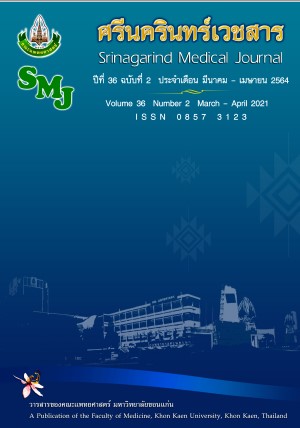ประสิทธิภาพของการใช้ค่า apparent diffusion coefficient ของ diffusion-weighted magnetic resonance imaging ประเมินความสามารถในการวินิจฉัยก้อนเนื้อร้ายแรงในตับ
Abstract
หลักการและวัตถุประสงค์: ค่า ADC (Apparent diffusion coefficient) สามารถอธิบายลักษณะของก้อนเนื้อในตับ การศึกษาก่อนหน้านี้มีความแตกต่างของค่า ADC ที่เหมาะสมในการแยกระหว่างก้อนเนื้อไม่ร้ายแรงและก้อนเนื้อร้ายแรงในตับ การศึกษาครั้งนี้มีวัตถุประสงค์ เพื่อวัดค่า ADC ของก้อนเนื้อร้ายแรงในตับและระบุจุดตัด ADC ที่เหมาะสมในการวินิจฉัยแยกระหว่างก้อนเนื้อไม่ร้ายแรงและก้อนเนื้อร้ายแรง
วิธีศึกษา: เป็นการศึกษาย้อนหลังโดยการเปรียบเทียบค่า ADC ของ 180 รอยโรคของตับที่ได้รับตรวจวินิจฉัยโรคด้วยคลื่นแม่เหล็กไฟฟ้า (MRI; Magnetic resonance imaging) (ระหว่างวันที่ 1 มิถุนายน 2555 ถึงวันที่ 31 ธันวาคม 2557 พร้อมหาค่าจุดตัด ADC เพื่อแยกระหว่าง ก้อนเนื้อไม่ร้ายแรงและก้อนเนื้อร้ายแรงในตับ
ผลการศึกษา: ก้อนเนื้อร้ายแรงในตับ 79 รอยโรค (CCA (Cholangiocarcinoma) 52, HCC (hepatocellular carcinoma) 20, liver metastastais 7) มีค่าเฉลี่ย ADC เท่ากับ 1.06x10-3มม2/วินาที และก้อนเนื้อไม่ร้ายแรงในตับ 101 รอยโรค (hemangioma 44, FNH 11, hepatic adnoma 7, cyst 39) มีค่าเฉลี่ย ADC เท่ากับ 1.93x10-3มม2/วินาที ซึ่งมีความแตกต่างอย่างมีนัยยะสำคัญทางสถิติ (p<0.05) จุดตัดค่า ADC ที่เหมาะสมในการวินิจฉัยก้อนเนื้อร้ายแรงคือ 1.49x10-3มม2/วินาที ด้วย sensitivity 84.8%, และ specificity 81.2%
สรุป: ค่า ADC ของก้อนเนื้อร้ายแรงมีค่าน้อยกว่าก้อนเนื้อไม่ร้ายแรงในตับอย่างมีนัยยะสำคัญทางสถิติ จุดตัดค่า ADC ที่เหมาะสมในการวินิจฉัยแยกโรคของก้อนเนื้อร้ายแรงในตับเท่ากับ 1.49x10-3มม2/วินาที
คำสำคัญ: การถ่ายภาพด้วยคลื่นสนามแม่เหล็ก(MRI); ค่าสัมประสิทธิ์การแพร่กระจายที่ชัดเจน(ADC); มะเร็งท่อน้ำดี (CCA) ; มะเร็งตับ (HCC) ; การแพร่กระจายของตับ
Background and Objective: ADC (Apparent diffusion coefficient) values have been shown to be helpful for liver lesion characterization. There are; however, discrepancies in the ADC values and controversies regarding the optimal cutoff ADC values to differentiates malignant from benign liver lesions. The purpose of this study was to measure ADC values of malignant liver lesions and to identify the optimal cutoff ADC value to differentiate malignant from benign liver lesions.
Material and Methods: A retrospective study of 180 MRI (Magnetic resonance imaging) of liver during June 1, 2012 to December 31, 2014. ADC value was measured and compared between benign and malignant liver lesions. The optimal ADC value to differentiated between malignant and benign liver lesions was calculated.
Results: Seventy-nine malignant liver lesions included 52 CCAs, 20 HCCs, 7 liver metastases had median ADC value 1.06x10-3 mm2/sec. 101 benign liver lesions included 44 hemangiomas, 11 FNHs, 7 hepatic adenomas and 39 cysts had median ADC value 1.93x10-3 mm2/sec. The differences between the median ADC values of malignant liver lesions (1.06x10-3 mm2/sec) and benign liver lesions (1.93x10-3 mm2/sec) was statistically significant (p<0.05). The ADC value of <1.49x10-3 mm2/sec was the optimal cut-off values to indicate malignant liver mass with the sensitivity of 84.8%, specificity of 81.2%.
Conclusion: ADC value is useful for differentiating malignant from benign liver lesions with1.49x10-3 mm2/s as optimal cutoff ADC value.
Keyword: Magnetic resonance imaging (MRI) ; Apparent diffusion coefficient (ADC) value; Cholangiocarcinoma (CCA) ; hepatocellular carcinoma (HCC) ; liver metastasis, hemangioma ; focal nodular hyperplasia (FNH) ; hepatic adenoma; cyst


